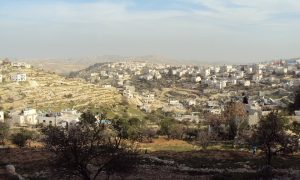Palestine Economic Update May 2024
By The Palestine Economic Policy Research Institute (MAS)
Key Developments
- Israeli forces have closed key crossings, including the Rafah and Erez Crossings, preventing aid from entering Gaza. This has led to severe shortages of fuel and essential supplies, hindering humanitarian operations.
- The ongoing war is projected to push the poverty rate to 60.7% across Palestine, significantly increasing the number of people living in poverty.
- Gaza’s development has been set back by 40 years, with reconstruction efforts expected to require up to $50 billion.
- A new maritime corridor has been established to facilitate aid delivery, but it faces logistical and security challenges and does not adequately address the core issues of aid distribution.
- Israel has imposed financial sanctions on the Palestinian National Authority (PNA), withholding clearance revenues again and threatening the stability of the Palestinian banking system by cutting off Palestinian banks from their Israeli correspondent banks.
- The PNA is implementing austerity measures and seeking international support to navigate the fiscal crisis, focusing on rationalizing spending and increasing revenues amid severe economic and political challenges.
- Humanitarian Situation Update
As Israel’s aggression enters its ninth month, the humanitarian and socioeconomic conditions throughout the Gaza Strip continue to deteriorate. By May 22, according to official Palestinian sources, the death toll had surged to over 36 thousand, including 15 thousand children and 10 thousand women, with more than 7 thousand Palestinians missing under the rubble and approximately 85 thousand injured.1 Satellite data as of May 8 shows that 57.5% of buildings in the Gaza Strip are likely damaged or destroyed by continuous bombardment, displacing 2mn residents.2 Northern Gaza remains the hardest-hit region, with 70% of buildings likely damaged or destroyed, while devastation spreads as Israel expands its military offensive southward from Khan Yunis, hitting 36% of buildings in Rafah thus far. OCHA reports a depletion of shelter materials in Gaza and a lack of safe locations for sheltering.3 As of May 20, twenty-one hospitals in Gaza are entirely out of service, and only 15 are partially operational.4 The destruction of essential services, including 60% of WASH services, coupled with mass overcrowding and fuel shortages, is driving disease rates. There have been over 760,000 cases of acute respiratory infections and 410 cases of acute watery diarrhoea. With only 45% of primary healthcare centres operational, the health situation is increasingly alarming. Around 88% of the population faces emergency and catastrophic food insecurity levels (IPC 4 and 5), rendering the state of food insecurity nearly irreversible.5 A recent UN report projects the poverty rate to surge to 60.7% across Palestine, including the West Bank, if the war extends to nine months, pushing an additional 1.86 mn people into poverty.
- Blocking Aid Delivery
On May 6, Israeli forces began the long-threatened invasion of Rafah, the southernmost governorate in the Gaza Strip. Once a refuge for over 1.5mn displaced Palestinians, Rafah has witnessed the forced displacement of nearly 800,000 people over the past weeks, moving northwards en masse, mostly having fled Israeli fire multiple times since October 2023.7 The humanitarian and socioeconomic situation is dire in the areas they have been displaced to along the central coast, exacerbated by decreasing aid and a lack of public facilities and basic necessities. On May 7, Israeli forces assumed control of the Rafah Crossing between Gaza and Egypt and later closed the Erez Crossing on May 9, effectively sealing all primary and secondary crossings of the Gaza Strip and preventing aid from entering.8 Additionally, aid trucks via the Jordanian Corridor traversing the occupied West Bank faced blockade campaigns, with some humanitarian supplies, especially food, being directly attacked, set alight or destroyed by gangs of Israeli settlers as police and security forces looked on.9 Since May 6, only 654 liters of fuel have been delivered to Gaza, a quarter of the usual amount since October 2023.10 Humanitarian organisations in Gaza require at least 46,000 liters of daily fuel to sustain their operations.
The fuel shortage severely hampers the delivery of the limited aid entering Gaza and threatens future aid via the maritime corridor. This shortage impacts the capacity of hospitals to perform medical interventions, disrupts the distribution of shelter, water, and non-food items, and creates operational challenges for water production, treatment, and waste management. The military operation in Rafah has also disrupted recent progress in food access, with the closure of the Rafah Crossing having halted the delivery of at least 82,000 metric tons of supplies and thousands of trucks loaded with rotting food aid and other supplies waiting over the border in Egypt.
Aid delivery in the southern Gaza Strip faces significant obstructions similar to those in the North. Just over half of requested aid missions in the south were facilitated by Israel, while 20% were denied, 6% were impeded, and 20% were cancelled due to logistical constraints.
The WFP’s main warehouse in Rafah is now inaccessible, endangering displaced residents across the Strip. WFP food and fuel stocks are nearing depletion amidst this closure.
Of the 32 humanitarian aid missions, only nine reached the North following Israeli approval, while the rest were either denied (5 missions), impeded (11 missions), or cancelled due to logistical hurdles (7 missions).
Additionally, 101 crucial distribution points have lost contact with the WFP, severely impacting efforts to address the needs of newly displaced people. By May, 10% of children under two in Rafah are suffering from acute malnutrition. UN Appeal, Again On 17 April, the Palestinian Territories Flash Appeal was extended in response to 12 significant operational constraints hindering effective humanitarian aid.17 The appeal seeks $2.8bn to support 3.1mn targeted Palestinians between April and December 2024, with 90% of the funds directed towards the Gaza Strip.
The dire conditions in Gaza are starkly evident, with looming famine likely affecting the northern region. The Food Security Cluster has the largest funding requirement of $782.1mn, 87% of which is allocated to Gaza. Additional funding requirements include Shelter and Non-Food Items ($423.1mn), health ($408.5mn), WASH ($305.6mn), and multi-purpose cash assistance ($244.1mn), among other operational clusters. This appeal marks the third extension since the aggression began.
The original appeal in October 2023 sought $294mn, and after a first revision in November 2023, the appeal increased to $1.2bn to mitigate mass devastation and fund efforts until December 2023.18 As the conflict persisted, a subsequent extension until March 2024 called for an additional $600mn. By the end of 2024, the total cost of the humanitarian devastation wrought by this war will have reached at least $4.6 bn. 2. Gaza Maritime Corridor On 17 May, aid deliveries commenced via the U.S.-built humanitarian floating pier off the Gaza coast. The offshore facility, including a land-anchored causeway, was announced by the US in March to serve as a gateway for large ships carrying essential aid such as food, water, medicine, and temporary shelter.
This maritime corridor begins in Larnaca, Cyprus, where supplies are loaded to ships destined exclusively for Gaza under Israeli security controls, and is designed to complement existing borders by streamlining access for an additional 90 trucks in its initial phase, with a plan to increase to 150 trucks later.
On May 17-18, the first and second shipments, consisting of 15 truckloads of aid, were unloaded at a UN warehouse in Deir al-Balah, central Gaza Strip, and received by the World Food Program.21 These first shipments totalled 455 metric tons of food and aid.22 By May 22, a total of 820.5 metric tons of aid had arrived at the floating dock, with 506 metric tons subsequently delivered to the UN warehouse.23 On May 20, after two days of halted aid delivery through the pier ,24 US National Security Advisor Jake Sullivan proposed a strategy to boost aid delivery into Gaza, ensuring more aid reaches Gaza through all crossings.25 This plan involves leveraging all entry points, including maritime routes, and establishing permanent corridors within Gaza to ensure swift and reliable aid distribution. The project was initially announced as a 90- day mission beginning in May. Gaza requires an average of 500 trucks daily to support its population of 2.2mn.
The daily average peaked in April at 200 trucks, the highest since October 2023.26 The situation has since deteriorated, with Israel assuming control of the Rafah Crossing and allowing minimum aid to be delivered through the Erez or other available Israeli crossings. On 26 May, Egypt agreed with the United States to allow UN humanitarian aid to flow into Gaza temporarily through the Karem Abu Salem crossing, at the intersection of Gaza, Egypt and Israel, until the Rafah crossing is reopened.27 Two hundred aid trucks entered on the first day.
Logistics In terms of logistics, aid shipments will first arrive in Cyprus for Israeli security inspections before heading to Gaza.28 Once aid reaches the floating dock, smaller boats transfer it to a 550-meter causeway to the Gaza shore, where it will be loaded onto trucks for distribution. 29 This causeway, built using a “Joint Logistics Over-the-Shore” model, is intended for shipto-shore operations when port facilities are inadequate or unavailable.30 The project, costing an estimated $320mn and involving 1,000 US military personnel, is anchored near the centre of the Strip rather than its originally intended location near Ashdod port in northern Gaza.31 Aid entering through this pier, which is protected by an Israel security bubble, is adjacent to the Israeli-established Netzarim corridor, a military road bisecting the Gaza Strip and a bottleneck for humanitarian deliveries to the northern Strip, complicating aid entry and distribution. According to an Oxfam official, the corridor attempts to solve a non-existent problem while failing to address Israel’s restrictions and the targeting of humanitarian aid.32 Consequently, this initiative does not address the core challenge of aid distribution or facilitate aid delivery to northern Gaza, nor does it address the issue of aid successfully passing through Israeli obstacles. It complicates humanitarian efforts and hinders aid from reaching those most in need.33 Furthermore, concerns about Israeli inspections in Cyprus are timely, given Israel’s restrictions on humanitarian aid, not just since October but also within the broader context of the 16-year blockade. Since October 2023, Israel restricted access to even some necessities, including animal feed, essential items for water purification, power generation, shelter construction, and various medical supplies like crutches, anaesthetics, and oxygen cylinders.34 2.2 Militarisation under Humanitarianism On May 7, Israeli forces closed both the Rafah and Kerem Shalom crossings, with the Erez Crossing between northern Gaza and Israel reopening only recently. Consequently, only six truckloads of aid entered Gaza between May 6-14.35 The modular causeway appears redundant given the existence of three primary crossings, a framework for operating Rafah crossing and a seaport, as highlighted in the 2005 Agreement on Movement and Access (see below). Additionally, the Israeli Ashdod port can deliver aid to Gaza via UN agencies, as originally planned, if maritime deliveries are necessary and beneficial.
Maritime aid delivery poses logistical risks and requires maritime permissions, which Israel can easily deny. Even if approved, the number of truckloads via the maritime corridor does not meet the aid delivery needs.
The physical facility has even faced technical challenges as some moveable elements detached in the rough seas of Gaza on 25 May.36 Humanitarian nongovernmental agencies have pointed out that existing crossings could suffice, suggesting a political agenda behind the floating causeway.
The floating pier initiative was first formulated as the “Blue Beach Plan”, to be operated by FOGBOW, a humanitarian relief company founded in 2022 by former US military and CIA personnel.38 The company aims to “deliver aid where it is most needed,”
delivery ‘dance’ to avert 36 employing three barges capable of carrying 175 tons each, sailing directly from Cyprus to Gaza under FOGBOW’s management.
So far, there is no indication that FOGBOW has engaged with the maritime corridor. Earlier in this war on Gaza, US President Biden emphasised the importance of strengthening Israel’s security within the broader framework of US security interests and Middle East interventions. This idea aligns with a FOGBOW executive’s proposal in 2022 for a multinational regional force involving Israel and Gulf States, supported and advised by the US, with security objectives framed within a humanitarian framework.
US involvement in Israeli security, especially concerning the Gaza Strip, is not new. However, the siting of the facility integrated into the Israeli eastwest security corridor raises questions as to whether the facility, once fully operative, risks creating a justification for the prolonged Israeli occupation of the Strip and internal security control. There are also serious ethical considerations arising from the fact that a humanitarian project such as the port area and logistics facilities, as well as the military road that Israel built bisecting Gaza, were all constructed through the destruction of homes and property and forced displacement of inhabitants of the area.41 2.3 A new lease on life for the Agreement on Movement and Access? As the war has shifted the political and other goalposts that prevailed until 2023, the relevant framework for organising Gaza’s access to the rest of the world acquires paramount importance. Reviving previously agreed frameworks for goods access, such as the 2005 Agreement on Movement and Access (AMA), the last signed agreement between the PLO and Israel seems to be the correct legal and effective entry point for bolstering and sustaining humanitarian aid.
The US was a key player in reaching that historic agreement and remains implicated in its restoration. Historically, Palestinians have long advocated for the establishment of a Palestinian seaport, particularly during the Oslo process and subsequent years. The AMA provided Palestinians with the opportunity to establish a commercial seaport free from Israeli intervention and designed according to Palestinian development needs and vision.
However, the seaport was never realised, leaving Palestine without access to its coastal borders. The AMA aimed to foster peaceful economic development and improve the humanitarian situation in Gaza, with the Rafah Crossing designated as a hub for continuous, securitised movement of persons and goods. Under the AMA framework, the Palestinian Authority and Egypt were to operate the Rafah Crossing according to Palestinian law, with security monitoring by the EU and Israel. The US was tasked with providing security services and coordinating security matters between Israel and the PNA, and Egypt to solve occurring issues.
The framework for the newly established floating pier eliminates both Egyptian and Palestinian involvement, placing complete control of oversight and inspection in the hands of the US and Israel, while the UN solely handles aid delivery. 3. Ever-mounting Costs of Reconstruction as the war on Gaza ends its eighth month, with Israel expanding its military offensive into Rafah, international organisations continue to highlight the extensive destruction and humanitarian catastrophe faced by Gazans, many of whom have been repeatedly displaced.
On May 1, UNESCWA and UNDP released a joint update report detailing the 42 https://peacemaker.un.org/sites/ socio-economic impacts of the war, noting that Gaza’s development has been set back by 40 years.43 All improvements in Gaza’s Human Development Index (HDI) since the 1980s have been erased. While the West Bank is relatively less affected, it is projected to experience 14 to 16 years of setbacks. These assessments underscore the war’s long-lasting impact on all aspects of life in Palestine, with the potential to create “lost generations” as the replacement of critical infrastructure like schools and hospitals may take decades to reach pre-war levels.44 Abdallah Al Dardari, director of the Regional Bureau for Arab States at the UNDP, estimated that Gaza’s reconstruction will require up to $50bn.45 An early recovery program, aimed at providing temporary shelters, community support, and essential services for displaced populations, would cost between $2 to $3 bn over three years.46 This would exceed the above-mentioned budget for humanitarian aid through 2024 (of some $4.5 bn). MAS has estimated the cost of an emergency universal basic income programme for Gaza for 12 months at $3.5 bn.
The UN report warns that replacing destroyed facilities, such as schools and hospitals, may take decades to reach pre-war levels. In the best-case scenario, the report estimates reconstructing destroyed infrastructure and homes would take until 2040. The latest estimates indicate that the war has left approximately 37mn tonnes of debris, including about 800,000 tonnes of asbestos and other contaminants, as well as some 7,500 tonnes of unexploded ordnance.48 This poses a long-term threat to life, potentially taking up to 14 years to clear. A massive accumulation of solid waste, totalling 75,000 tonnes, further presents severe environmental and health risks.
The spread of hepatitis and skin diseases has already been reported among the stranded populations due to these conditions.50 Furthermore, the presence of mass graves, makeshift graves, and decomposing bodies under the rubble threatens to create a public health crisis even before the rubble can be removed.
The remnants of municipal services are insufficient to manage the enormous amounts of waste and debris, as much of the necessary equipment, machinery, and fuel have been destroyed or depleted during the conflict. Needless to say, the strategic decision of how and where to dispose of the physical detritus of this war remains a primary concern. 4. Deepening Fiscal Crisis On 22 May, the far-right Israeli Minister of Finance, Bezalel Smotrich, demanded a range of sanctions against the Palestinian National Authority (PNA) in response to the decisions by Spain, Ireland, and Norway to recognise a Palestinian state.52 Among other punishments against the PNA on which he demanded Government action, Smotrich announced measures within his Ministerial purview, particularly ceasing to authorise transfers of the trade taxes Israel collects on behalf of the PNA, beginning with those due for April. Last month, Smotrich withheld March clearance revenues (after a range of unilateral deductions) for nine days, citing the PNA’s alleged involvement in the International Criminal Court (ICC) investigation against Israeli officials for purported violations of international law during the Gaza war. This forced the PNA to pay only 50% of the civil sector March salaries in April after a payment 49 while the balance of April was paid in mid-May.
The PNA is already struggling with a severe fiscal crisis due to Israel’s increasing punitive deductions from clearance revenues since 2019, totalling $1.2 bn by March 2024 or 24% of the PNA’s public revenues in 2023.53 The PA already owes over five months of backpay to its employees, so Smotrich’s plan to halt clearance revenues and not unfreeze those amounts illegally deducted threatens to cripple the PNA further, and international observers now warn that it could lead to its collapse.54 Furthermore, Smotrich indicated that Israel may not renew a waiver that expires on July 1 that allows Israeli banks to process shekel payments for services and salaries tied to the PNA, cutting off Palestinian banks from their Israeli correspondent banks.55 In a recent update, on May 27, the Ministerial Committee for Legislation of the Israeli Knesset approved a draft law to seize withheld clearance funds.
If enacted, this bill would allocate all deductions withheld since 2019 to the Israeli treasury. Additionally, approximately ILS 60 million per month would be seized if the PNA does not cease its payments to the families of those imprisoned or killed by Israel.56If implemented, this could have daunting consequences on the Palestinian banking system and economy in general. In 2023, Palestinians imported $4.4 bn worth of goods from Israel (62.4% of total imports, including electricity, water and fuel) and exported $1.3 bn worth of goods (86.1% of total exports), most of which were done through financial transactions between Israeli and Palestinian banks. The PMA has reassured the public that the banking system remains solid and that any such measures would not affect Palestinian banking relations with the rest of the world.
Nevertheless, the matter appears to be of such alarm to warrant a Group of 7 Finance Ministers’ statement to demand that Israel halt its financial sanctions against the PA.58 4.1 Public Finance Following the war on Gaza and a severe economic recession, the PNA public revenues dropped by 24.8% in Q1 2024 compared to Q1 2023 on an accrual basis and 31.4% after accounting for Israel’s punitive deductions from clearance revenues.59 Domestic revenues decreased by 29.1% to $1.4bn (38.7% of net revenues), and clearance revenues (before deductions) dropped by 22.7% to $2.3bn (62.2% of net revenues). Total public expenditure and net lending, on the other hand, fell by 3.1% to $3.9bn. In Q1 2024, wages and salaries accounted for 52.1% of public spending or 143.5% of domestic revenues.
In Q1 2024, public debt reached $3.9bn (12.9% increase compared to Q1 2023), most of which is domestic debt (65.5%) to banks and local institutions, as well as some international debt liabilities. Furthermore, the PNA had about $4bn in arrears to the private sector, public servants and others in Q1 2024, a 25.7% increase compared to Q1 2023. The public debt and arrears totalled $7.9bn in Q1 2024, 45.2% of the Palestinian GDP in 2023, a ratio that is bound to rise close to a critical threshold of 60% as GDP plummets in 2024. Compounding the PNA’s financial crisis, budget support has been minimal, amounting to only $84.8mn in Q1 2024. 4.2 Austerity Measures The new Palestinian government, which took office in March, faces an uphill navigating the fiscal crisis amid a political impasse and calls by Israeli officials to dismantle the PNA.60 The newly appointed Palestinian Prime Minister, Mohammad Mustafa, outlined three key priorities for the government: easing the suffering of Gazans, stabilising finances, and improving institutional performance.61 The PNA operates under an emergency plan to efficiently allocate available funds to meet the Palestinian people’s most pressing needs and priorities.62 The main focus (and daily struggle) is disbursing monthly wages and social transfers as an essential function amidst the economic recession. The new government is implementing austerity measures and reforms to rationalise spending, increase revenues, and address liquidity issues. Approved by the Cabinet on April 23, 2024, the plan includes financial and administrative reforms based on ten principles to enhance governance. These reforms focus on strengthening central governance, improving the justice sector, enhancing democracy and human rights, boosting public sector efficiency, reforming the security sector, improving health and education services, reforming public finances, enhancing local governance, integrating digital transformation, and strengthening the economic sector. The austerity measures target reducing expenditures on government vehicles, travel, contracts, and purchases.
They also aim to improve the appointment process to ensure merit, transparency, and equal opportunities and to implement the Presidential decree on retirement age while limiting exceptions. The government plans to review and reform the cybercrime law to ensure it aligns with rights and freedoms, prepare a comprehensive report on state institutional governance, 8 coordinate with the private sector for relief efforts in Gaza, and assess economic losses following the war on Gaza. Additionally, a new salary calculation formula ensures that the lowest-income employees (earning up to ILS 3,000 monthly), who make up about 40% of the workforce, receive their full salaries while remaining employees receive a portion of their salaries based on available resources.63 Furthermore, the PNA has sought international aid and support to pressure Israel to release withheld funds, mainly focusing on the ILS 1.8bn held under Norway’s escrow, which includes punitive deductions since October and ILS 900mn in border fees collected but not transferred by Israel.64 However, the combined financial, political, and security challenges, alongside the PNA’s strained relations with Israel, hinder the chances of a resolution. 4. April Trading Activity.
The Al-Quds Index decreased by 0.3% in April 2024 compared to the previous month, reaching 541.1 points on the last trading day.65 4.8mn shares worth $8.4mn were traded during the month, marking a 62.9% and a 65.7% increase in the number and value of traded shares compared to March 2024.
Read full report: The Palestine Economic Policy Research Institute (MAS)



























